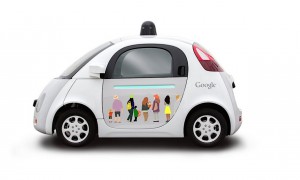Google’s autonomous vehicle program has achieved a significant milestone as it moves closer to being production-ready.
The National Highway Traffic Safety Administration has told the high-tech firm that the artificial intelligence system used in its prototype vehicles can be considered the same as a human driver according to federal regulations.
Google had sought that ruling in a letter sent to NHTSA last November in which it claimed the vehicles have “no need for a human driver.” The high-tech project is in the midst of rolling out about 100 specially designed prototypes designed to test the latest version of Google self-driving technology under real-world conditions. The company wants to remove even the traditional steering wheel and pedals from some of those prototypes.
“We agree with Google its (self-driving car) will not have a ‘driver’ in the traditional sense that vehicles have had drivers during the last more than one hundred years,” NHTSA stated in a letter to Google that it also posted on the agency’s website, reports the Reuters news service.
NHTSA’s ruling could make it easier for Google to move forward with its autonomous vehicle program, considered by many experts to be the most advanced in the industry. The subsidiary of holding company Alphabet recently announced plans to expand its test program – now centered around Google campuses in Silicon Valley and Austin, Texas. It hopes to get broader geographic experience and to learn how the vehicles perform in more varied weather conditions.
A handful of states, including California, Nevada, Florida and Michigan, have specifically established autonomous vehicle guidelines. Some others, such as Texas, have said existing rules apply.
(Automakers face serious challenges in bringing autonomous vehicles to market, says Toyota’s new tech chief. Click Here for more.)
The NHTSA ruling could create a potential conflict, however, as proposed regulations recently announced by California authorities would prevent Google from fielding its completely driverless vehicles, those with no mechanical driver controls at all. A passenger would only be able to enter a destination or hit a shutoff button in event of an emergency.
NHTSA cautioned that it has not yet decided whether Google can eliminate all vehicle safety systems that would normally be available for a human driver, however, such as a foot-operated brake pedal.
“The intricate maze of legal questions surrounding autonomous vehicles is as big a hurdle to their arrival as the remaining technological challenges,” said Karl Brauer, an analyst with Kelley Blue Book. “However, if NHTSA is prepared to name artificial intelligence as a viable alternative to human-controlled vehicles, it could substantially streamline the process of putting autonomous vehicles on the road.”
For its part, Google told Reuters it is still evaluating the NHTSA ruling.
But the company is clearly intent on moving forward as quickly as possible. Google has said that it does not intend to produce its own vehicles, but whether it would simply license its technology to an existing maker, or perhaps contract out production of a Google-mobile, is not clear.
(Google wants partners – but won’t say if Ford will be one of them. Click Here for more.)
During a visit to Detroit last month, John Krafcik, the head of Google’s autonomous vehicle program, said “In the next stage of our project, we’ll be partnering more and more and more. We have to figure out the right set of partnerships to unlock.”
Krafcik pointedly avoided discussing a spate of news reports that Google was lining up its first partnership with Ford Motor Co. For its part, Ford said it is also looking for high-tech partners but declined to discuss whether Google might be one of those.
During Krafcik’s Motown visit, the executive joined in on an announcement at the 2016 Detroit Auto Show by U.S. Transportation Secretary Foxx. The nation’s auto safety czar promised to take steps to make it easier for automakers and high-tech firms like Google to test their latest autonomous vehicle systems.
(Nissan and partner Renault plan to launch numerous autonomous vehicles. Click Here for more.)



What NHTSA actually stated is that they will hold GOOGLE liable for all damages, losses, injuries and deaths from any Google autonomous vehicle sold and operated on U.S. roadways because there is no designated driver. That is NOT what Google was hoping for. They wanted NHTSA to say that no one is liable because there is no designated driver. Google got slammed big time in their efforts to deceive NHTSA.
Unfortunately authorities around the globe have abdicated their responsibility to establish proper safety requirements, vehicle design and construction guidelines, hardened security, redundant control systems, appropriate limp modes, certified AV maintenance by licensed, skilled techs such as in the aircraft industry and annual inspections of AVs before people start dying. We will get the knee-jerk response as soon as the first fatalities are reported. With over 270 Google AV roadway errors so far and several accidents from improper programming, it won’t take long for the first injuries to occur.